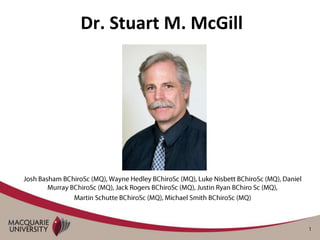
Stuart McGill
- 1. Dr. Stuart M. McGill
- 3. Biography- Roles & Qualifications Dr Stuart McGill (Associate Professor) Director of the Spine Biomechanics Laboratory, University of Waterloo, Ontario Canada. B.PhysEd (Toronto), M.Sc (Ottawa) PhD (Waterloo)
- 4. Biography - Achievements A highly recognized researcher and lecturer in spinal biomechanics, function, rehabilitation and injury prevention Currently over 200 publications Editorial board of several scientific journals including Spine Numerous academic awards and invited lectureships Runs spine-related workshops and clinical courses worldwide
- 5. Publications
- 6. Assessment of Methodology- Literature Search
- 7. Assessment of Methodology- Intended search terms: MeSH Chiropractic Association of Australia CAA, (2012)
- 8. Assessment of Methodology- Inclusion/Exclusion Criteria
- 9. Contributions to Research University of Waterloo Spine Biomechanics Laboratory ‘…to understand how the low back functions; to understand how it becomes injured; and, knowing this, formulate and investigate hypotheses related to prevention of injury and optimal rehabilitation of the injured back, and ultimate performance of the athletic back.’ in vitro and in vivo facilities development of the ‘McGill model’ virtual spine Generation of hypotheses regarding spinal injury mechanism, prevention, rehabilitation, and optimum performance
- 10. Contributions to Research- McGill Model: Virtual Spine PART ONE High speed cameras capture joint movement caused by load placed in the upper Reaction moments at L4-5 generated through linked-chain equation Reaction moments converted into 3-D motion at L4-5 through pelvic and spine markers
- 11. Contributions to Research- McGill Model: Virtual Spine PART TWO determines how the forces are transferred into load placed upon the spine and paraspinal tissues based on: The kinematics of the individual’s spine the deformation characteristics of passive tissues muscle activation via surface EMG
- 12. Description of Research- Understanding Spinal Stability McGill’s key findings of Spinal Stability; Co-activation of musculature Superposition of multidirectional muscle fibers Muscle contraction produces a force and stiffness Stiffness created by muscle contraction will always act to stabilize “Super Stiffness” the stability provided by the co-activation of the musculature
- 13. Description of Research-Protocols for Back Rehabilitation Exercises Protocol for Back Rehabilitation Exercises- The 6 Stage Approach 1.Corrective exercise 2. Perfect motion and motor patterns 3.Build whole body and joint stability 4. Increase endurance 5. Build strength 6. Develop speed, power and agility
- 14. Description of Research- The “Big 3” The Curl Up The Bird-Dog The Side Bridge
- 15. Evaluation McGill’s biomechanical research is of high quality There are some potential biases arising from subject demographics Rehabilitation and injury prevention protocols are evidence-based and well- reasoned There is a need for clinical trials (RCTs) to determine the efficacy across the general population and different subgroups
- 16. Conclusion McGill has made a field-leading contribution to spinal biomechanics research Rational development of scientific research findings in to clinical applications Challenged existing ‘clinical wisdom’ and has explained observed phenomena Has provided an evidence-based framework for further research into spinal injury prevention, rehabilitation and optimum performance
- 17. (1) Waterloo Uo. McGill, Stuart M. 2012 [cited 2012 09/10]; Available from: (2) Waterloo Uo. Stuart McGill Research. 2012 [cited 2012 08/10]; Available from: http://www.ahs.uwaterloo.ca/~mcgill/. (3) McGill S. Low Back Disorders: Evidence-Based Prevention and Rehabilitation. 2nd ed. Champaign, IL, USA: Human Kinetics Publishers; 2007. (4) McGill S. Ultimate Back Fitness and Performance. 4 th ed. Waterloo, Ontario, Canada: BackfitproInc; 2009 (5) Waterloo Uo. Spine Biomechanics Laboratory. 2012 [cited 2012 08/10]; Available from: http://www.ahs.uwaterloo.ca/kin/people/SpineBiomechanicsLab.html. (6) McGill SM, Juker D, Axler C. Correcting trunk muscle geometry obtained from MRI and CT scans of supine postures for use in standing postures. Journal of Biomechanics. 1996;29(5):643-6 (7) McGill SM, Norman RW. Effects of an anatomically detailed erector spinae model on L4L5 disc compression and shear. Journal of Biomechanics. 1987;20(6):591-600. (8) McGill SM, Norman RW. Dynamically and statically determined low back moments during lifting. Journal of Biomechanics. 1985;18(12):877-85. (9) McGill SM. Lumbar loads from moments about three orthopaedic axes: Developing the architecture of a 3-D occupational low back model. Journal of Biomechanics. 1992;25(7):810. (10) McGill SM. A myoelectrically based dynamic three-dimensional model to predict loads on lumbar spine tissues during lateral bending. Journal of Biomechanics. 1992;25(4):395-414. (11) Cholewicki J, McGill SM, Norman RW. Comparison of muscle forces and joint load from an optimization and EMG assisted lumbar spine model: Towards development of a hybrid approach. Journal of Biomechanics. 1995;28(3):321-31. (12) Sutarno CC, McGill SM. Force velocity investigation of the erector spinae muscles. Journal of Biomechanics. 1994;27(6):744. (13) McGill S, Juker D, Kropf P. Appropriately placed surface EMG electrodes reflect deep muscle activity (psoas, quadratuslumborum, abdominal wall) in the lumbar spine. Journal of Biomechanics. 1996;29(11):1503-7. (14) McGill S. Ultimate Back Fitness and Performance. 3rd ed. Waterloo, Canada: BackFit Pro Inc; 2004. (15) Kavcic, N., Grenier, S.G., and McGill, S.M. (2004a) Determining tissue loads and spine stability while performing commonly prescribed stabilization exercises. Spine, 29(11): 1254-1265. (16) Kavcic, N., Grenier, S., and McGill, S. (2004b) Determining the stabilizing role of individual torso muscles during rehabilitation exercises. Spine, 29(11):1254-1265. (17) Brown, S. H. M. and S. M. McGill (2005). "Muscle force-stiffness characteristics influence joint stability: a spine example." Clinical biomechanics (Bristol, Avon) 20(9): 917-922. (18) Callaghan, J.P., and McGill, S.M. (2001) Intervertebral disc herniation: Studies on a porcine model exposed to highly repetitive flexion/extension motion with compressive force. Clinical Biomechanics, 16(1): 28-37. (19) Axler, C., and McGill, S.M. (1997) Low back loads over a variety of abdominal exercises: Searching for the safest abdominal challenge. Medicine and Science in Sports and Exercise,29(6):804-811.